
[Segment of the original Reinheitsgebot of 1516. Credit: Deutscher Brauer-Bund e.V.]
If you’re a beer enthusiast or perhaps fond of German beer, this probably isn’t the first time you’ve heard about the “Reinheitsgebot”, or the (Beer) Purity Law of 1516. And with 2016 marking the 500th anniversary of arguably the most famous piece of beer legislation the world has ever known, it probably won’t be the last you hear of it either.
But just because the Reinheitsgebot is one of the most famous beer laws doesn’t mean it’s the most well understood.
So with that, here’s a quick rundown of ten things you might not know about the Reinheitsgebot:
1. Meaning and pronunciation of “Reinheitsgebot”: In German, “Rein” means “pure”, “Reinheit” means “purity”, and “Gebot” means “commandment” (“The Ten Commandments”/”Die Zehn Gebote”), “decree” or “ordinance”, but “Gebot” is typically translated in this case as “law”. Therefore, “Reinhietsgebot” is translated as “Purity Law”, commonly referring to beer Purity Law.
The law itself dictates, among other things, the ingredients that may be used to make beer. To be clear, only one sentence of the original Reinheitsgebot of 1516 discusses limiting beer ingredients, while the rest of the document mainly focuses on setting price limits on the sale of beer. Some speculate that the main impetus behind the creation of the Reinheitsgebot of 1516 was to protect consumers from brewers who may add dangerous ingredients to beer potentially poisoning the public, while others believe that in addition there were more economic motives involved (more on that later).
The correct way to pronounce “Reinheitsgebot” is like this: “Rine Heights Ge-Boat”, not “Rine Heights Ge-Bot” where “Bot” is pronounced like “Robot”.
2. There are technically two different beer Purity Laws that German breweries might be following: The Bavarian Reinheitsgebot or the German Reinheitsgebot.
In fact, many German breweries will often specifically indicate on the beer label which of the two Purity Laws their beer falls under as you can see on the images below:
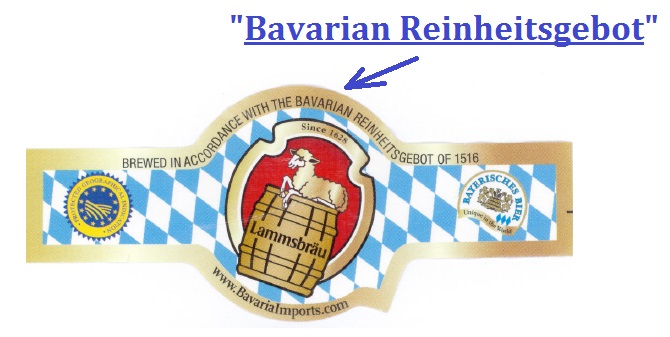
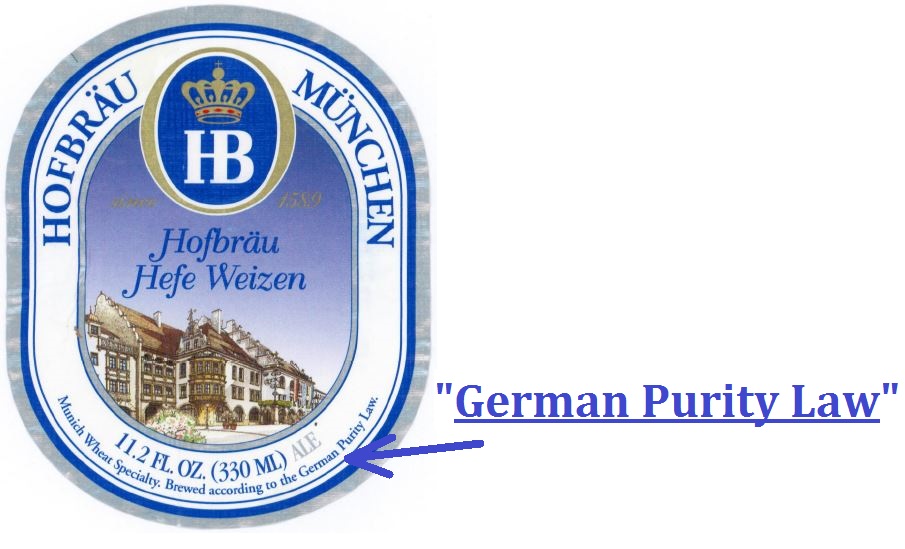
And of course, sometimes the brewery isn’t exactly clear which “Reinheitgebot” they’re following as you can see in the label below that merely states “brewed according to the Reinheitsgebot”.
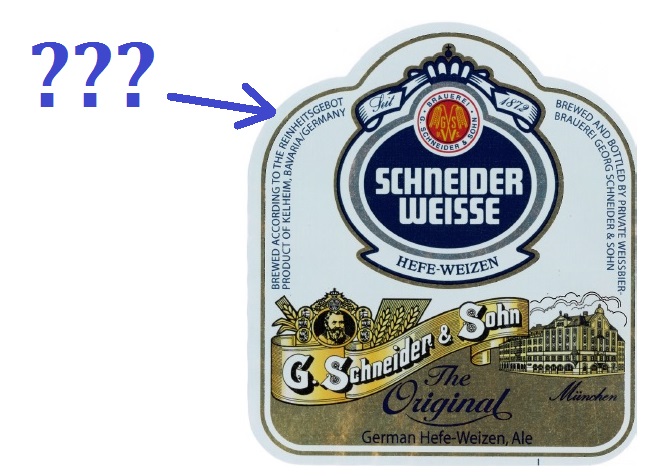
Nevertheless, the distinction between the two Purity Laws is made not just because “Germany” didn’t even exist as a country in 1516 (that only happened in 1871), and therefore there was no “German Reinheitsgebot of 1516”, but also because the two Purity Laws are themselves objectively different with respect to the ingredients allowed in making beer, with the German version being the more lenient of the two:
A) The Bavarian Reinheitsgebot of 1516: The only ingredients used for the brewing of beer must be barley, hops and water. [1]
B) The German Reinheitsgebot: Bottom-fermented beer (lager) may only contain barley malt, hops, water, and yeast. Top-fermented beer (ale) must include barley malt, hops, water, and yeast, but it is also permittable to use other malts, pure cane sugar, beet or invert sugar, as well as colorants derived from modified starch sugar and any of the aforementioned sugars. [2] If you wanted to put a date on what is referred to as the original “German Reinheitsgebot”, you could nail it down to May 31st, 1872 when Germany enacted the “Law Concerning Levying Brewing Tax” (Gesetz wegen Erhebung der Brausteuer), however the ingredients listed above come from the “Notice Concerning the Version of the Brewing Tax Act” from June 7th, 1906 (Bekanntmachung, betreffend die Fassung des Brausteuergesetzes), which was a modification to the original German Reinheitsgebot of 1872.
3. Mark your calendars! The official date of the 500th anniversary of the Bavarian Reinheitsgebot of 1516 is April 23, 2016, which conveniently happens to fall on a Saturday. Accordingly, we recommend starting the celebration with a tall cool glass of your favorite Reinheitsgebot beer on Friday at midnight.
(Wouldn’t it be cool if some breweries got the crazy idea to brew a special “Reinheitsgebot beer” to mark the occasion? Hmmm…)
4. Many sources claim that the Reinheitsgebot is the oldest, still valid food safety law in the world. Technically, that statement isn’t exactly true… and that’s putting it nicely.
First of all, the Reinheitsgebot was officially repealed by the European Court of Justice in 1987 because it was found to be in direct violation of the Rome Treaty (Article 30, banning protectionism). [3] This repeal thus allowed German brewers to produce beer for export with no regard to the Reinheitsgebot. So, technically the Reinheitsgebot isn’t “still valid”.
Secondly, the Reinheitsgebot of 1516 was not the oldest food regulation in the world. Take, for example, the 1493 Duchy of Lower Bavaria Beer Decree which limited beer ingredients to malt, hops, and water. Before that there was the Münchner (Munich) Reinheitsgebot of 1487, and before that was the Runneburg “Wirtshausverordnung” (“Statuta thaberna”) of 1434 which stated that beer may only be brewed from hops, malt and water. [4][5]
Then of course there’s the “Novus Modus Fermentandi Cervisiam”(New Method for Fermenting Beer) introduced by Emperor Charles IV in 1364 which decreed that all beer brewed throughout the Holy Roman Empire must be brewed with hops. [6] There were even earlier beer laws: one from Erfurt in 1351, and yet another from Nuremberg in 1293. Laws and regulations specifically concerning food and alcohol existed in ancient Rome, [7] and depending on how you look at Kosher food regulations from the Talmud/Old Testament, you have a pretty solid argument against the Reinheitsgebot of 1516 being the earliest law that regulated food or food safety.
Nor has the Reinheitsgebot of 1516 remained essentially unchanged since its inception because as of the mid-1500s, Bavaria started to allow for other ingredients in making beer like coriander, laurel, etc. [8]
5. Neither the Bavarian nor the German Reinheitsgebot originally allowed for yeast as an ingredient. Now, if you know a little bit about brewing science, you know that it would have almost certainly been impossible to make beer back then without yeast.
So what’s the deal with the Reinheitsgebot missing this key ingredient?
Simple. People didn’t know about the role that yeast played in fermentation in 1516. According to the history books, Dutch naturalist Anton van Leeuwenhoek was the first to microscopically observe yeast in 1680 (although he didn’t consider yeast to be a living organism), [9] while French microbiologist Louis Pasteur was the first to prove that indeed living yeast was responsible for alcoholic fermentation in 1857. [10] Eventually, the Reinheitsgebot was revised to include yeast in 1906.
6. If the Bavarian Reinheitsgebot of 1516 only allowed for three ingredients (barely, hops, and water), how was it then that wheat beers like Hefeweizen, Berliner Weisse or Gose were allowed to be brewed in Germany after 1516? Well, it was hinted at above, but the Bavarian Reinheitsgebot was updated beginning in the mid-1500s to allow for other ingredients including wheat. [11] (In 1616, caraway, juniper, and salt were added to the Reinheitsgebot, which allowed Gose, a beer brewed with salt, to be considered Reinheitsgebot-friendly.) [12]
Some speculate that the reason wheat [and rye] were intentionally excluded from the Reinheitsgebot of 1516 was to better control the grain-based food supply in Bavaria so that bakers could have sufficient access to wheat grain in order to produce bread in a time of food scarcity, [13] and also to prevent price competition between the brewers and bakers. Others go further and suggest that there were indeed profit-driven motives behind the legislation as evidenced by the powerful Wittelsbach family of Bavaria (in particular, Dukes William IV and Louis X), who originally enacted the Reinheitsgebot, and later profited by selling special wheat beer brewing rights. [14]
7. In 2013, the German Brewers Association attempted to have the Reinheitsgebot added to UNESCO’s Intangible World Heritage List, a list that already includes the Flamenco of Spain, Mariachi music of Mexico, and the coffee culture of Turkey. [15] The Brewers Association’s application was initially rejected, but there’s still a chance it could get approved if the paperwork is appropriately revised and resubmitted. [16]
8. Bavaria demanded that their Reinheitsgebot be adopted by Germany in 1871 as a precondition to joining the new German nation. Bavaria’s condition was met. After the first German Empire fell following World War I, a new German unification took place forming what was called the “Weimar Republic” in 1919 (officially known as the “German Reich”). Again, Bavaria refused to join unless their Reinheitsgebot was adopted by the rest of the newly reformed country. Bavaria’s condition was met. Again. [17]
9. Even though the Bavarian Reinheitsgebot of 1516 is old, it only started being called the “Reinheitsgebot” as of March 4, 1918. Prior to the term being coined by Hans Rauch of the Bavarian State Parliament in 1918, the “Reinheitsgebot” was simply known as the “Surrogatverbot”, or “Surrogate (Adjunct) Prohibition”. [18]
10. In the 19th century, Greece incorporated a nearly identical version of the Reinheitsgebot into Greek law. [19] This Greek law was later struck down around the time the Reinheitsgebot was repealed in Germany in 1987. [20]
Test Your Knowledge
Based on the information above, what’s wrong with the following two beer labels?
1. Hint: The text at the top of the Rex Pils label states “Nach dem Deutschen Reinheitsgebot von 1516 Gebraut”, or “Brewed According to the German Reinheitsgebot of 1516.”
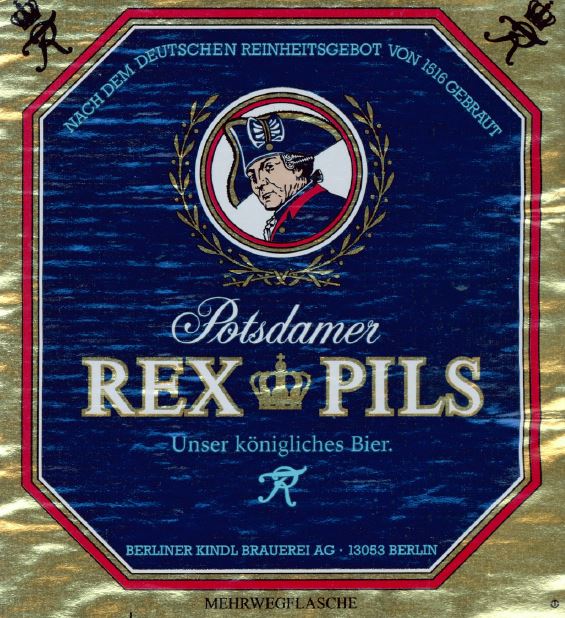
2. Hint: The small text at the top of the Erdinger Hefe-Weizen label reads “Getreu dem bayerischen Reinheitsgebot von 1516”, or “True to the Bavarian Reinheitsgebot of 1516.” The only other thing you need to know is that “Hefe-Weizen” is a wheat beer.
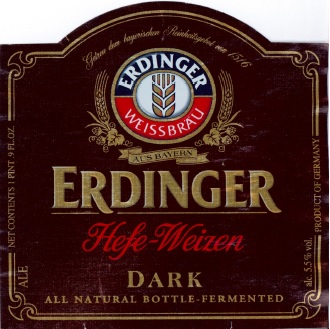
[Check the Answers on the Next Page]
[expand title=”References: (Click to View)“]
1. 
[Original segment of the Reinheitsgebot highlighted to indicate the sentence documenting allowable ingredients (transcription and translation below). Credit: Deutscher Brauer-Bund e.V.]
Original German text: “Wir wollen auch sonderlichen / das füran allenthalben in unsern Stetten / Märckthen / unn auf dem Lannde / zu kainem Pier / merer stückh / dann allain Gersten / Hopfen / unn wasser / genommen unn gepraucht sölle werdn.”
Modern German translation: “Ganz besonders wollen wir, daß forthin allenthalben in unseren Städten, Märkten und auf dem Lande zu keinem Bier mehr Stücke als allein Gersten, Hopfen und Wasser verwendet und gebraucht werden sollen.”
Typical English translation of the modern German translation: “Furthermore, we wish to emphasize that in future in all cities, markets and in the country, the only ingredients used for the brewing of beer must be Barley, Hops and Water.”
2. Deutsches Reich Law Gazette Volume 1906, No. 32, page 675 -. 693 [§ 1. Bierbereitung. Zur Bereitung von untergärigem Biere darf nur Gerstenmalz, Hopfen, Hefe und Wasser verwendet werden. Die Bereitung von obergärigem Biere unterliegt derselben Vorschrift, es ist jedoch hierbei auch die Verwendung von anderem Malze und von technisch reinem Rohr-, Rüben- oder Invertzucker, sowie von Stärkezucker und aus Zucker der bezeichneten Art hergestellten Farbmitteln zulässig.]
3. Swinnen, Johan F. M. (2011-10-27). The Economics of Beer. OUP Oxford.
4. Gaab, Jeffrey S. (2006-01-01). Munich: Hofbräuhaus & History: Beer, Culture, & Politics. Peter Lang. p. 10.
5. Hales, S. D. (2007). Beer & Philosophy: The Unexamined Beer Isn’t Worth Drinking (pp. 25). Malden, MA: Blackwell Pub.
6. Van Uytven, R. Geschiedenis van de Dorst. Twintig Eeuwen Drinken in de Lage Landen (Pp. 74-76). Davidsfonds Leuven, 2007.
7. Albala, Ken (2015-03-27). The SAGE Encyclopedia of Food Issues. SAGE Publications. p. 1488. ISBN 9781506317304.
8. Karin Hackel-Stehr: Das Brauwesen in Bayern vom 14. bis 16. Jahrhundert, insbesondere die Entstehung und Entwicklung des Reinheitsgebotes (1516). Dissertation. Berlin 1987, pp. 2450, 2472.
9. Huxley A (1871). “Discourses: Biological & Geological (volume VIII) : Yeast”. Collected Essays. Retrieved 22 January 2016.
10. Barnett JA. (2003). “Beginnings of Microbiology and Biochemistry: the contribution of yeast research”. Microbiology (Reading, Engl.) 149 (3): 557–567.
11. Karin Hackel-Stehr: Das Brauwesen in Bayern vom 14. bis 16. Jahrhundert, insbesondere die Entstehung und Entwicklung des Reinheitsgebotes (1516). Dissertation. Berlin 1987, pp. 2450, 2472.
12. Herrmann, S. (2016, January 22). Viel Bier vor vier. Retrieved January 26, 2016, from http://www.sueddeutsche.de/politik/jahre-reinheitsgebot-viel-bier-vor-vier-1.2830364
13. Opinion of Advocate General Slynn in Case 178/84 Commission v. Germany, delivered Sept. 18, 1986.
14. Herrmann, S. (2016, January 22). Viel Bier vor vier. Retrieved January 26, 2016, from http://www.sueddeutsche.de/politik/jahre-reinheitsgebot-viel-bier-vor-vier-1.2830364
15. Sarhaddi Nelson, S. (2013, December 18). Is A 500-Year-Old German Beer Law Heritage Worth Honoring? Retrieved from http://www.npr.org/sections/thesalt/2013/12/17/251959392/is-a-500-year-old-german-beer-law-heritage-worth-honoring
16. Reinheitsgebot vorerst als UNESCO Weltkulturerbe abgelehnt – ein Appell! (2015, February 18). Retrieved from http://www.lieblingsbier.de/2015/02/18/reinheitsgebot-vorerst-als-unesco-weltkulturerbe-abgelehnt-ein-appell/
17. Swinnen, Johan F. M. (2011-10-27). The Economics of Beer. OUP Oxford.
18. Oliver, G. (2012). The Oxford Companion to Beer (pp. 692). New York: Oxford University Press.
19. Swinnen, Johan F. M. (2011-10-27). The Economics of Beer. OUP Oxford.
20. Glenny, Misha (1986-09-25). Last orders for Reinheitsgebot. New Scientist.
[/expand]
Like this blarticle? Well, thanks- we appreciate you!
Tweet-worthy? That would be kind of you: Tweet
Want to read more beer inspired thoughts? Come back any time, friend us on Facebook, or follow us on Twitter:
Or feel free to drop me a line at: dan@beersyndicate.com
Hi, I’m Dan: Beer Editor for Beer Syndicate, Beer and Drinking Blogger, Gold Medal-Winning Homebrewer, Beer Reviewer, AHA Member, Beer Judge, Shameless Beer Promoter, and Beer Traveler.
Pages: 12





FXB
Nice article, very informative.
Greg Hansen
I’ve had the same though about Hacker-Pschorr’s Weisse. “Brewed according to the Bavarian Purity Law of 1516”, the carrier says. No, it’s not! I didn’t pursue it, but I thought they might say that, despite changes to the law over the years, it derives from the 1516 law, so the pedigree makes it a fair claim. And that might actually have been a better reply than Erdinger’s, which amounts to “It’s okay if we lie to the customers because they don’t take it seriously, either.”
Compliance with the Reinheitsgebot is certainly an important factor for the German consumer, even if he can’t explain exactly what that means. It’s like it’s code for “the way beer should be”, even if we don’t know how it should be.
The long version of the reply (thank you for including the reply) says that wheat was considered superior to barley, and that if the consumer today receives something that, from his point of view, is better or more valuable than he expected, then we can’t call it deception. But I’m going to say no, if it’s not compliant with the 1516 law then you shouldn’t say it is.